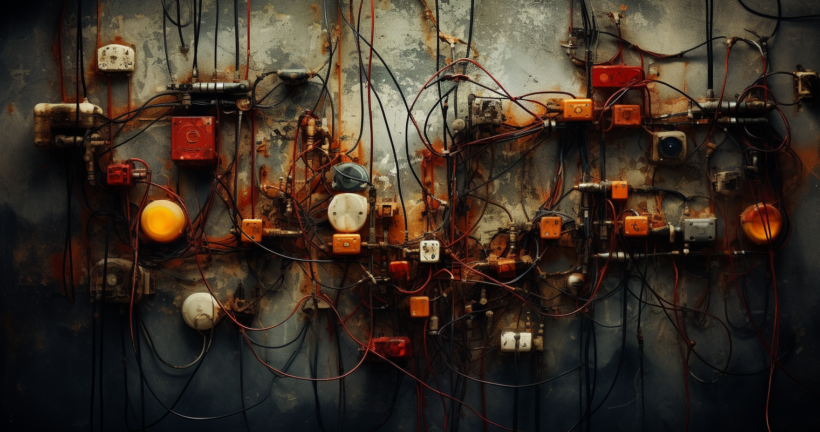“What Is Considered Old Electrical Wiring?” If you’re living in a house that was built more than 40 years ago, there’s a high chance that the electrical wiring is outdated. Old electrical wiring not only poses safety risks like fires and electrical shocks but also might not be able to handle the electrical load of modern appliances. According to the National Fire Protection Association, electrical failures or malfunctions were the second leading cause of U.S. home fires in 2012-2016.
Identifying Old Electrical Wiring
It’s not uncommon to unearth some hidden “gems” when renovating an old house. Sometimes it’s an antique coin, other times it’s old electrical wiring. But how do you know if the wiring is old? There are a few telltale signs. First, cloth-insulated wiring. This type of wiring is often black or brown, covered in a fabric-like material, and may be brittle to the touch.
Next, knob and tube wiring. This wiring, often found in homes built before the 1930s, involves individual wires anchored by porcelain-insulating tubes. Lastly, non-metallic wiring. This wiring uses plastic sheathing instead of metal conduit and is considered outdated. Old wiring can pose several risks including fire hazards, shock risks, and code violations. You can read more about the safety of old house wiring here.

Types of Old Electrical Wiring
| Type of Old Wiring | Description |
|---|---|
| Knob and Tube Wiring | One of the oldest types of wiring, commonly found in homes built between 1880 and 1930. Utilizes porcelain knobs and tubes for wire routing, lacks grounding, and is considered unsafe. |
| Cloth-Insulated Wiring | Features fabric insulation, often in black or brown, which can deteriorate over time, posing fire risks and exposure to live wires. |
| Aluminum Wiring | Used as a cheaper substitute for copper in the 1960s and 70s. Prone to oxidization, corrosion, and loosened connections, creating fire hazards. |
For a deep dive into What Is Strain Relief In Electrical Wiring? A Detailed Guide, Check out this article on our website.
When to Replace Old Electrical Wiring
The age of the wiring is a significant factor in deciding whether it needs replacement. If your house is over 40 years old, it’s a good idea to get the wiring checked. However, age isn’t the only indicator. Signs of wear and tear such as frayed insulation, exposed wires, or scorch marks on your outlets or switches indicate that the wiring needs replacement.
Additionally, frequent electrical issues such as flickering lights, buzzing sounds, or circuit breaker trips can indicate the need for wiring replacement. Don’t wait for a spark to ignite; learn more about when to replace old electrical wiring here.

How to Replace Old Electrical Wiring
Replacing old electrical wiring is not a DIY task. It requires specialized skills and knowledge, which is why hiring a professional is crucial. A licensed electrician can accurately assess the condition of your wiring, recommend the necessary repairs or replacements, and execute the job safely and efficiently.
The process of replacing old wiring typically involves three main steps:
- Inspection: The electrician will first conduct a thorough inspection of your home’s electrical system to determine the extent of the problem and the amount of work required.
- Removal of Old Wiring: The old wiring will then be carefully removed to avoid any damage to the walls or ceilings.
- Installation of New Wiring: New, up-to-code wiring will be installed to replace the old wiring.
The cost of replacing old wiring can vary significantly based on several factors, including the size of your home, the complexity of the job, and the region where you live. However, you can generally expect to pay anywhere from $1,500 to $10,000 for a complete rewiring of an average-sized home. Check out this guide for more details on identifying wiring in an old house.
Electrical Upgrades for Older Homes
Older homes often have electrical systems that are not up to current safety standards. Therefore, upgrading the electrical panel is essential. The electrical panel, also known as the breaker box, is the heart of your home’s electrical system. It distributes electricity to the various circuits in your home. Upgrading the panel will ensure that it can handle the electrical load of your home and reduce the risk of fire hazards.
Installing GFCI outlets is another important upgrade for older homes. GFCI, or Ground Fault Circuit Interrupter, outlets are designed to protect you from electrical shocks by automatically shutting off the power if a ground fault is detected. These outlets are particularly important in areas of the home where water is present, such as bathrooms, kitchens, and laundry rooms.
Completely rewiring the house is often necessary in older homes. Rewiring involves replacing all the old wiring with new, up-to-code wiring. This process can be time-consuming and costly, but it is a crucial investment in the safety of your home.
What Is Considered Old Electrical Wiring is not just about identifying the old wiring, but also about taking the necessary steps to replace it and upgrade your home’s electrical system. Safety should always be the top priority, so don’t cut corners when it comes to your home’s wiring.

What Is Considered Old Electrical Wiring? An Expert’s Opinion
The topic of old electrical wiring is a critical one, as it can have serious implications for the safety of your home. Modern wiring standards have evolved significantly over the years to address the increased electrical load of modern homes and to improve safety.
Expert recommendations for replacing old electrical wiring vary based on several factors, including the age of the wiring, its condition, and local building codes. However, a general rule of thumb is to consider replacing your home’s wiring if it is more than 40 years old if you are experiencing frequent electrical issues, or if your home still has knob and tube wiring or cloth-insulated wiring. More information about old electrical wiring can be found here.
Maintaining electrical safety in older homes is crucial. Here are some tips for maintaining electrical safety in older homes with old wiring:
- Regular inspections: Regular inspections by a licensed electrician can help identify potential issues before they become major problems.
- Use surge protectors: Surge protectors can help protect your home’s electrical system and your electronic devices from damage due to power surges.
- Avoid DIY repairs: While it may be tempting to try to fix electrical issues yourself, it is always best to hire a professional electrician to ensure the job is done safely and correctly.
Preventive Measures for Old Electrical Wiring
Preventing issues with old electrical wiring is always better than dealing with the consequences of neglect. Here are some preventive measures for older homes with old wiring:
- Regular inspections: As mentioned above, regular inspections by a licensed electrician are crucial for maintaining the safety of your home’s electrical system.
- Using surge protectors: Surge protectors are devices that protect your electrical appliances from voltage spikes. They are particularly important in homes with old wiring, as old wiring is more susceptible to power surges.
- Avoiding DIY repairs: DIY repairs can be dangerous and can often lead to more problems down the line. It is always best to hire a professional electrician to handle any electrical repairs or upgrades.
More information on why you should consider replacing old wiring can be found here.
Frequently Asked Questions
What Is Considered Old Electrical Wiring?
Old electrical wiring typically includes knob and tube wiring, cloth-insulated wiring, and aluminum wiring.
What are the risks associated with old wiring? The risks associated with old wiring include:
- Fire hazards: Old wiring can overheat and ignite surrounding materials.
- Shock risks: Deteriorated insulation can expose live wires, leading to electric shocks.
- Code violations: Old wiring often does not meet current electrical codes, which can be a problem when selling your home or making insurance claims.
How can I identify old electrical wiring? Common signs of old electrical wiring include:
- Cloth-insulated wiring
- Knob and tube wiring
- Non-metallic wiring
- Frequent electrical issues such as flickering lights, buzzing sounds, and circuit breaker trips.
When should I replace the old electrical wiring? You should consider replacing old electrical wiring if:
- Your home is more than 40 years old.
- You experience frequent electrical issues.
- Your home has knob and tube wiring or cloth-insulated wiring.
Can I replace the old electrical wiring myself?
It is strongly advised against attempting to replace old electrical wiring yourself. Replacing electrical wiring involves significant risks and requires specialized knowledge and skills. It is always best to hire a licensed electrician to handle any electrical repairs or upgrades.
Conclusion
What Is Considered Old Electrical Wiring is crucial for the safety of your home. If your house is more than 40 years old, experiences frequent electrical issues, or has knob and tube or cloth-insulated wiring, it is highly recommended to have a licensed electrician inspect and, if necessary, replace your home’s electrical wiring. Don’t wait until it’s too late; prioritize your safety and the safety of your loved ones by addressing old electrical wiring issues as soon as possible.
Thank you for reading!
